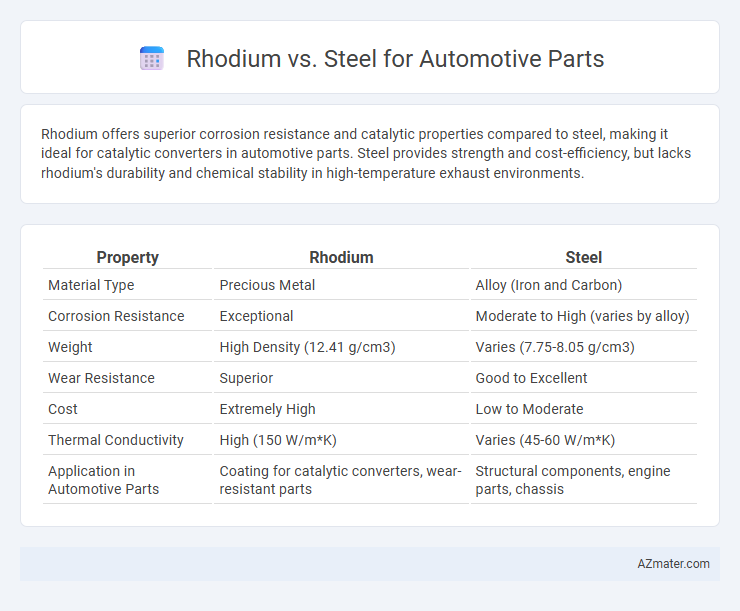Rhodium offers superior corrosion resistance and catalytic properties compared to steel, making it ideal for catalytic converters in automotive parts. Steel provides strength and cost-efficiency, but lacks rhodium's durability and chemical stability in high-temperature exhaust environments.
Table of Comparison
| Property | Rhodium | Steel |
|---|---|---|
| Material Type | Precious Metal | Alloy (Iron and Carbon) |
| Corrosion Resistance | Exceptional | Moderate to High (varies by alloy) |
| Weight | High Density (12.41 g/cm3) | Varies (7.75-8.05 g/cm3) |
| Wear Resistance | Superior | Good to Excellent |
| Cost | Extremely High | Low to Moderate |
| Thermal Conductivity | High (150 W/m*K) | Varies (45-60 W/m*K) |
| Application in Automotive Parts | Coating for catalytic converters, wear-resistant parts | Structural components, engine parts, chassis |
Introduction to Rhodium and Steel in Automotive Applications
Rhodium, a rare and precious metal, is prized in automotive applications for its exceptional corrosion resistance and catalytic properties, making it ideal for catalytic converters and sensors. Steel, widely used in automotive manufacturing, offers unmatched strength, durability, and cost-effectiveness, serving as the primary material for chassis, body panels, and engine components. The choice between rhodium and steel depends on application-specific requirements such as wear resistance, thermal stability, and economic factors.
Material Properties: Rhodium vs Steel
Rhodium exhibits exceptional corrosion resistance, high reflectivity, and superior hardness compared to steel, making it ideal for specialized automotive parts requiring durability and wear resistance. Steel, known for its tensile strength, toughness, and flexibility, offers cost-effective performance suitable for structural components and large-scale production. While rhodium significantly outperforms steel in resistance to oxidation and abrasion, its high cost and limited availability restrict its use primarily to coatings or niche applications in the automotive industry.
Corrosion Resistance Comparison
Rhodium offers superior corrosion resistance compared to steel, maintaining its integrity even in harsh automotive environments due to its noble metal properties and resistance to oxidation. Steel, particularly carbon steel, is prone to rust and corrosion unless treated with protective coatings like galvanization or stainless steel alloys. For automotive parts exposed to moisture, salt, and chemicals, rhodium plating provides a durable barrier against corrosion, extending part lifespan significantly beyond untreated or standard steel components.
Strength and Durability: Rhodium vs Steel
Rhodium exhibits exceptional hardness and corrosion resistance, making it highly durable for automotive parts exposed to harsh environments. Steel, particularly high-grade alloys, offers superior tensile strength and impact resistance, essential for structural components in vehicles. Comparing strength and durability, steel remains the preferred choice for load-bearing applications, while rhodium's resistance to wear and oxidation supports its use in protective coatings or specialized parts.
Weight Considerations in Automotive Parts
Rhodium is significantly denser than steel, which makes it less favorable for weight-sensitive automotive parts where minimizing mass improves fuel efficiency and performance. Steel, especially high-strength alloys, offers a better strength-to-weight ratio, balancing durability with lighter weight crucial for structural components. Weight reduction in automotive engineering prioritizes materials like steel to optimize vehicle dynamics and reduce emissions, whereas rhodium's density limits its application mainly to coating or catalytic purposes rather than structural parts.
Cost Analysis: Rhodium vs Steel
Rhodium, known for its exceptional corrosion resistance and high reflectivity, commands a significantly higher price per ounce compared to steel, impacting the overall cost of automotive parts manufacturing. Steel, a more affordable and widely available material, offers durability and strength at a fraction of rhodium's cost, making it the preferred choice for mass production. When analyzing cost-effectiveness, steel's lower material expense and ease of fabrication provide substantial savings despite rhodium's superior aesthetic and protective qualities.
Manufacturing Processes and Scalability
Rhodium coatings in automotive parts offer superior corrosion resistance and reflectivity but require complex and costly electroplating processes, limiting large-scale production feasibility. Steel, widely used in automotive manufacturing, benefits from established, high-efficiency fabrication methods such as stamping and welding, enabling mass production with scalable cost-effectiveness. The scalability of steel parts is enhanced by abundant raw materials and streamlined supply chains, whereas rhodium's rarity and intricate application present challenges for widespread automotive integration.
Environmental Impact and Sustainability
Rhodium's use in automotive parts, particularly catalytic converters, significantly reduces harmful vehicle emissions by efficiently converting toxic gases into less harmful substances, supporting cleaner air and environmental sustainability. Steel, while widely used for structural automotive components due to its strength and recyclability, has a higher environmental footprint due to energy-intensive mining and production processes, contributing to greenhouse gas emissions. Prioritizing rhodium-coated catalytic converters enhances vehicle emission control, while advancements in steel recycling and production aim to mitigate environmental impacts in automotive manufacturing.
Common Automotive Parts Using Rhodium and Steel
Common automotive parts using rhodium include catalytic converter components due to rhodium's exceptional resistance to corrosion and high catalytic efficiency in reducing harmful emissions. Steel is widely used in automotive parts such as chassis, engine blocks, and exhaust systems for its strength, durability, and cost-effectiveness. While steel dominates structural applications, rhodium is essential for enhancing emission control systems and catalytic converter performance.
Future Trends in Automotive Material Selection
Rhodium's exceptional corrosion resistance and electrical conductivity position it as a premium coating for automotive sensors and catalytic converters, while steel remains favored for its cost-effectiveness and structural strength. Future trends indicate a shift towards lightweight, corrosion-resistant materials, promoting increased rhodium use in hybrid and electric vehicle components to enhance efficiency and durability. Advancements in material science will likely drive hybrid alloys and composite materials, combining steel's robustness with rhodium's protective qualities to meet evolving performance and sustainability standards.

Infographic: Rhodium vs Steel for Automotive Part
 azmater.com
azmater.com